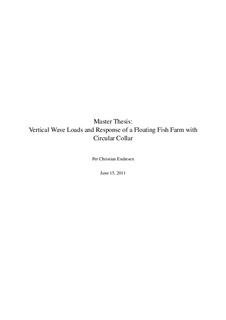| dc.contributor.author | Endresen, Per Christian | nb_NO |
| dc.date.accessioned | 2014-12-19T12:06:46Z | |
| dc.date.available | 2014-12-19T12:06:46Z | |
| dc.date.created | 2012-02-13 | nb_NO |
| dc.date.issued | 2011 | nb_NO |
| dc.identifier | 499981 | nb_NO |
| dc.identifier.uri | http://hdl.handle.net/11250/238000 | |
| dc.description.abstract | In this master thesis the vertical wave loads and vertical responses of the floating collar of a circular fish farm have been investigated. The response has been investigated for a collar without the presence of mooring system and net cage. First, a linear model was used to calculate displacements, relative motion between the floater and the surface and bending stresses. The linear displacements and bending stresses in regular long crested waves were compared with a nonlinear model for the excitation forces. The nonlinear excitation forces were obtained by integrating the hydrostatic and dynamic pressures over the exact wetted surface of the floater.
Two different configurations of the floating collar were investigated; a floater with only one plastic ring and a floater with two concentric rings. The radius and the displaced mass of the two configurations were equal. The response was calculated by mode superposition. The added mass is mode dependent, and thus a modal formulation of the added mass was used. The modal resonance frequencies for one ring were higher than the modal resonance frequencies for two rings. The three first resonance frequencies for two rings, corresponding to heave, pitch and the first elastic mode, are 2.25 rad/s, 2.69 rad/s and 2.91 rad/s. The relative motion for low wave frequencies is higher for one ring than for two rings. The bending stresses are significantly higher for two rings between a wave frequency of 1.5 rad/s and 2.9 rad/s.
The linear model was used to calculate standard deviations for bending stresses in irregular waves. For low spectral peak periods the JONSWAP spectrum gave larger standard deviations for the bending stresses than the ISSC spectrum. For peak periods larger than 4.5s the ISSC spectrum gave the largest standard deviations.
For regular waves the linear and nonlinear model gave similar results for modal displacements and maximum bending stresses in the floater for small wave frequencies. At the modal resonance frequencies the nonlinear modal forces for the modes at resonance were significantly lower than the linear forces. This resulted in a reduced nonlinear response compared with linear theory at resonance. Damping was seen to only have a significant effect on the response at resonance for both the linear and nonlinear model. For some frequencies, modal excitation forces with frequencies two times, three times or higher than the incident wave frequency were observed. This induced higher frequency components in the response. The higher frequency components were close to the modal resonance frequency. Although the floater does not have forward speed, this kind of response from continueous wave loads can be associated with nonlinear springing response for ships. | nb_NO |
| dc.language | eng | nb_NO |
| dc.publisher | Norges teknisk-naturvitenskapelige universitet, Fakultet for ingeniørvitenskap og teknologi, Institutt for marin teknikk | nb_NO |
| dc.title | Vertical Wave Loads and Response of a Floating Fish Farm with Circular Collar | nb_NO |
| dc.type | Master thesis | nb_NO |
| dc.contributor.department | Norges teknisk-naturvitenskapelige universitet, Fakultet for ingeniørvitenskap og teknologi, Institutt for marin teknikk | nb_NO |
